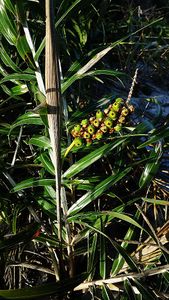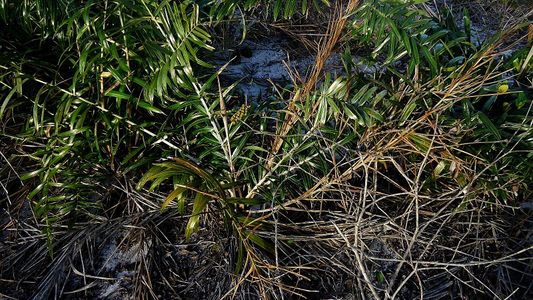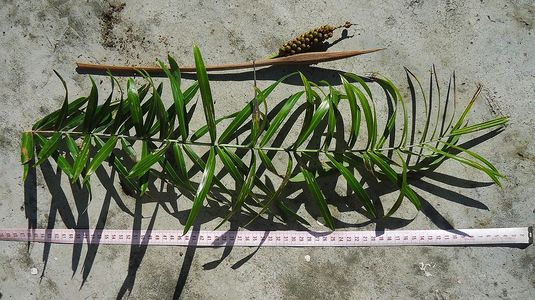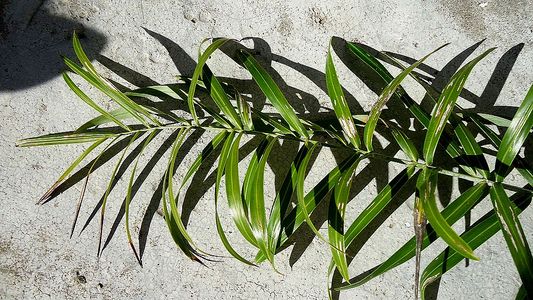Difference between revisions of "Allagoptera brevicalyx"
| Line 1: | Line 1: | ||
__noeditsection__ | __noeditsection__ | ||
| − | + | [[Image:P9120156.jpg|thumb|795px|left|Bahia, Brazil habitat. Photo: Jeff Marcus]] | |
| − | [[Image:P9120156.jpg|thumb| | + | |
{{Palmbox | {{Palmbox | ||
|image=P9120159.jpg | |image=P9120159.jpg | ||
Revision as of 11:24, 29 April 2014
| Allagoptera ((ahl-lah-gop-TEHR-ah) brevicalyx (brev-ih-KAHL-iks) | |||||||
|---|---|---|---|---|---|---|---|
 Brazil | |||||||
| Scientific Classification | |||||||
| |||||||
| Synonyms | |||||||
|
| |||||||
| Native Continent | |||||||
|
| |||||||
| Morphology | |||||||
| |||||||
| Culture | |||||||
|
| |||||||
| Survivability index | |||||||
|
| |||||||
| Common names | |||||||
|
| |||||||
Contents
Habitat and Distribution
Brazil Northeast. Endemic to Bahia and Sergipe. Brazil's atlantic coast, in white sand.
Description
Incredible waxy silver color, with hint of pink - spectacular.
Palm 1-2 m tall, stem to 2 m long, solitary, but subterranean, giving it the appearance of clustering. Leaves 4-8 in the crown; sheath and petiole densely tomentose; petiole 10-20 cm long, about 5 mm. in diam., densely covered with beige woolly indumentum; rachis 40-70 cm long, densely woolly-waxy; pinnae 25-40 per side, short lanceolate, with lobed tips, irregularly inserted in obscure groups of 1-4, 2-3 cm apart, spreading or appressed to rachis at various angles, plicate at base and densely covered with woolly hairs and ramenta, with evident midrib on both surfaces, with transverse veinlets not evident, green and lustrous adaxially, glaucous abaxially, the obtuse apex asymmetrically split for 0.5-4 cm; basal pinnae 15-25 x 0.4-1.8 cm; middle pinnae 10-22 x 0.7-2 cm; apical pinnae 4-9 x 0.2-0.9 cm. Inflorescences 55-95 cm long; peduncle 45-80 cm long, 0.4-0.6 cm. in diam., slender, muricate, scarcely to densely covered with floccose hairs and brownish scales; rachilla 10-15 cm long, bearing whitish woolly hairs; prophyll 25-30 cm, tubular, scarious; peduncular bract 50-90 cm long, 1.7-4 cm. in diam., apiculate, inflated above, woody, sulcate, beige-waxy externally, glabrous and brownish violet internally; peduncular bracts 1 or 2, brown scarious, dentate, at 2.5 em from apex of peduncle. Staminate flowers 3-4.5 mm long, pedicel to 1 mm, long , inserted parallel to perpendicular; sepals connate to the middle, glabrous, membranous, 2 about 2.5 x 1.5 mm, one larger about 3.5 x 1.5 mm, much smaller than the petals; petals valvate, connate to the middle, glabrous, membranous, about 6 x 2 mm; stamens 15, about 6 mm long, the filaments not columnar, about 1.5 mm long, the anthers about 4 mm long, sagittate at both ends; pistillode trifid. Pistillate flowers inserted on proximal 5-12 cm of rachilla, fibrous; sepals free, triangular, 3-5 x 3 mm, contorted to the left, glabrous, irregular to dentate on margin; petals free, triangular, 3-5 x 3 mm, imbricate to the right , glabrous; staminodial ring adnate to petals; pistil conical, 3-5 mm; stigma capitate, <1 mm with 3 short branches, wrinkled, glabrous. Fruit ovoid to turbinate, glabrous, 1.5-2 cm long, about 1.3 cm. in diam., perpendicular to rachilla, the stigmatic remnants truncate with stigmas sessile and minute, the persistent perianth <½, of fruit; seed 1. (Mónica Moraes)/Palmweb. Editing by edric.
This species varies greatly in the insertion of pinnae, which may be regular or irregular. Because of its sympatric distribution it has been identified as Allagoptera arenada since 1835, when the first collection was made by Blanchet. It is a very distinctive species by its short perianth which persists in fruit. Also distinctive are the turbinate, glabrous fruits, the irregularly arranged pinnae wilh a lobed apex, the dense layer of white hairs on the rachis and on the spicate inflorescence, and the incompletely fused calyx of the staminate flowers. Allagoplera brevicalyx is also distinctive by its occasional 2 m long stem, and a thick waxy layer on the adaxial leaf surface. Neither of these is present elsewhere in the genus. (Mónica Moraes)/Palmweb.
Culture
Comments and Curiosities
This is a tillering palm, it exhibits saxophone style root growth (it has a heel), keep top third of heel above soil elevation!
External Links
- Glossary of Palm Terms
- MODERN BOTANICAL LATIN
- "Just To Be Clear"
- Great info!
- THE SAXOPHONE STYLE ROOT GROWTH (HEEL)
References
Phonetic spelling of Latin names by edric.
Special thanks to Geoff Stein, (Palmbob) for his hundreds of photos, edric.
Special thanks to Palmweb.org, Dr. John Dransfield, Dr. Bill Baker & team, for their volumes of information and photos, edric.
Glossary of Palm Terms; Based on the glossary in Dransfield, J., N.W. Uhl, C.B. Asmussen-Lange, W.J. Baker, M.M. Harley & C.E. Lewis. 2008. Genera Palmarum - Evolution and Classification of the Palms. Royal Botanic Gardens, Kew. All images copyright of the artists and photographers (see images for credits).
Mónica Moraes. Flora Neotropica, monograph 73, Allagoptera. The New York Botanical Garden.
- IMAGE GALLERY
Many Special Thanks to Ed Vaile for his long hours of tireless editing and numerous contributions.









